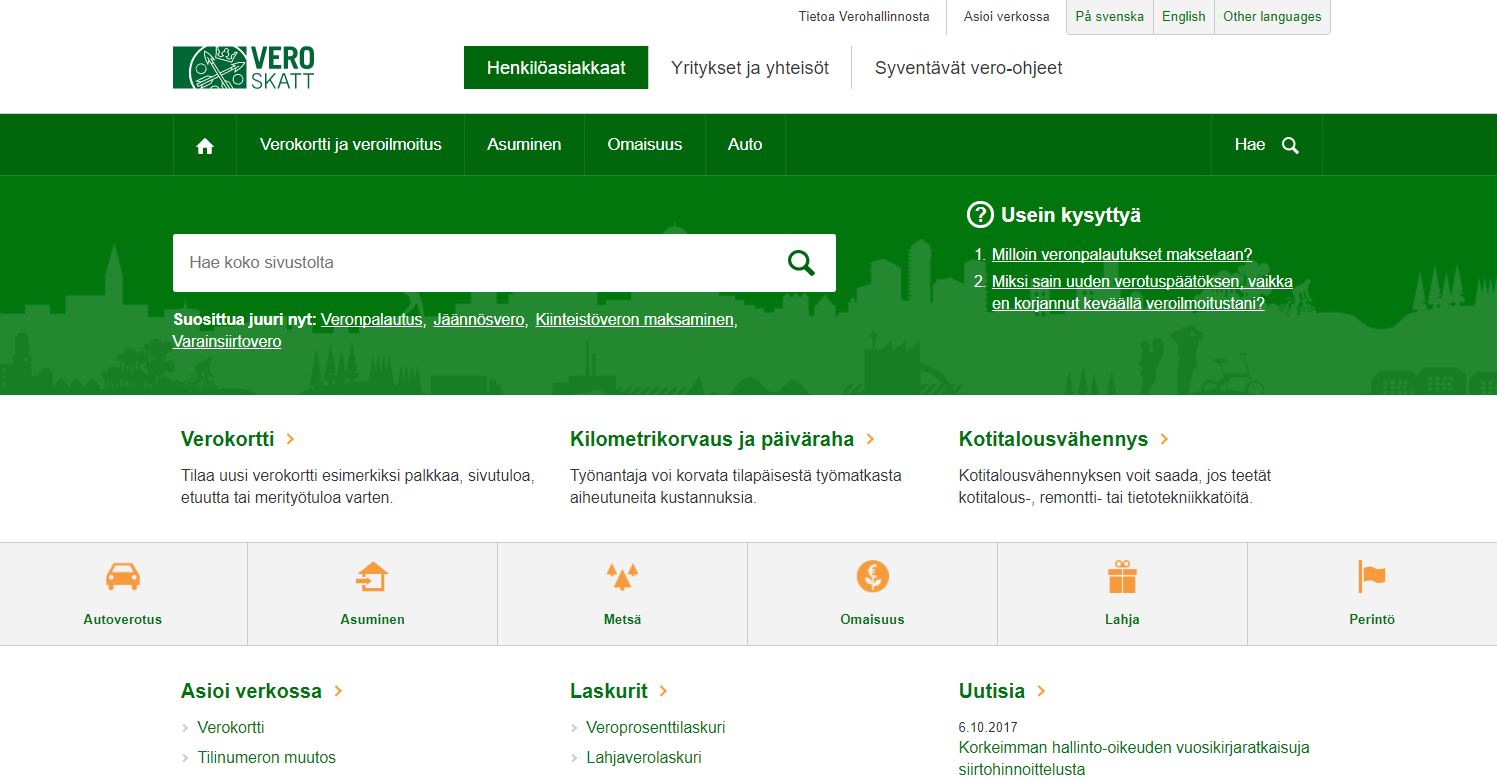The content management system for the Finnish Tax Administration web service, Vero.fi, has been renewed. User experience, search functions, and maintainability were significantly improved in the process.
North Patrol is a consulting firm specialized in the design of digital services and information systems. We shape ideas into a vision and service concept, find the best architectural and technological solutions, design a functional user experience, and compete to find the ideal partner for implementation work. We do not sell implementation projects, nor do we sell licenses; we are genuinely on the side of the customer.

Finnish Tax Administration has received praise (and awards) as a true pioneer among Finland’s public administration in developing e-services and digital solutions. However, redesigning the Tax.fi public information service and instructions archive had been delayed, Head of Digital Communications at Finnish Tax Administration Seniha Cihangir admits:
– Developing e-Services was prioritized over the website. Nonetheless, for us working at the Communications department, it was perfectly clear, that the public website is the number one customer service channel, and the benefits gained by improving it seemed obvious.
As the presentation logic at the Vero.fi site still relied upon a 10-year-old solution, the time was ripe to update the platform and modernize the user experience. The Communications department began the work by creating user interface concepts and ways of presenting content, generating user paths, and prioritizing different types of content within the web service.
Over the course of time, the Finnish Tax Administration had gathered a considerable amount of feedback and ideas both from external users and in-house personnel. That is why the problems that needed to be solved were well identified. North Patrol’s consultants helped Tax Administration’s representatives during the pre-study phase, during which the presentation layer and content management system alternatives were evaluated.
CMS selection before concept creation
When creating content for the Vero.fi service, modular page templates, flexible page layout, and reusable content all play a significant role. Therefore, Episerver CMS was defined as the optimal platform. This system was also very compatible with the Finnish Tax Administration’s information architecture. Outlining the concept and planning the whole renewal was efficient, since the system product was decided in advance. This made it possible to utilize the abilities of the system more thoroughly, and to design the layout solutions optimally according to Episerver’s features.
The Finnish Tax Administration chose the partner for planning the new concept and designing the user interface via the framework agreement procedure of the government’s central purchasing body, Hansel. The partner of choice for the concept design was Solita, who had solid experience as well as strong understanding of Episerver’s possibilities and limitations.
The new service concept for Vero.fi was outlined in more detail in partnership with Solita. By employing methods of service design, wireframe models for the website’s user interface were created.
The main renewal targets were the navigation and content structure, the form how persons are addressed on the site, how page templates can be browsed and what kind of functional mini-apps, such as selection wizards, are utilized.
User interface models were defined in greater detail in stages. A functional HTML prototype was created, which made it possible to test the user experience with actual user paths. Tax Administration refined the prototype model on their own, used it to clarify, present, and develop different ideas.
Questions related to taxation constitute a special domain, the intricacies of which are mastered by the Tax Administration experts. However, a regular client only has to deal with these questions once a year, and each time may very well feel like the first for them. Therefore, it was obvious that reliable feedback regarding the usability and understandability of the new Vero.fi service could only be obtained from end users.
For that reason, the development project included a great deal of testing, involving different testing teams at all stages.
Different testing methods for different purposes
Online service development ideas were tested with customer panels which consisted of personal and corporate customers. The panel was presented with development ideas that had been worked on, and comments were collected on e.g. how useful the ideas were, how well one could understand the demo models, and which of the alternative models were preferred.
These insights were a valuable source in understanding the customer’s way of interpreting and using the web service in front of them.
The problem with working with a test panel is, however, that the panelists work in constant collaboration, which leads them to learn the service too well. After a few meetings, the client panel will not be able to look at the models with a fresh eye of a first-time user – instead, the eye has become perceptive and analytical. There can only be one first impression of a web service!
Therefore, the test panel was more useful in iterating and designing sections for power users, such as accounting firms using the online service regularly.
In order to find unexperienced test users, the Finnish Tax Administration utilized guerrilla testing methods: the testing team sneaked upon unsuspecting people in e.g. university cafeterias, and asked them to perform a test by using the HTML prototype. Different testers were presented with different models, and the team even timed the participants, so that they could find out whether some models were able to reduce the time required to perform a certain task.
The most significant benefit for designing the Vero.fi service was that usability testing was done constantly to support the development work. As soon as a model was designed, it was tested by a couple of users, and the model was then refined based on feedback from the testers. The refined model was then tested again by using the same pattern.
Overall, more than a hundred people had eventually used or tested a version of the Vero.fi user interface during its development phase. Since the Tax Administration designers had observed the test procedure, they gained a great deal of insight on how people use the online service, and how users differ from each other.
Request for proposals and implementation with the emphasis on POC
As soon as the most important decisions regarding the new Vero.fi service concept and user experience had been made, a requirement specification based on utilizing Episerver was created. The requirements specification then served as a backbone for the request for proposals. Once again, North Patrol provided guidance in defining the specifications and outlining the RFP.
A particular feature in the Vero.fi request for proposals was that in the initial phase, Tax Administration only committed to purchasing a Proof of Concept (POC) pilot, which would be used to ensure successful content migration. Namely, transferring content materials automatically from the old system to the new one was absolutely critical in the Vero.fi update, because the Tax Administration’s specialist staff had a lot on their plate, and inputting content manually was something that no one desired.
Therefore, the prospective vendors were required to begin the implementation project by an initial phase in which a couple of content types would be migrated from the old Vero.fi services to new Vero.fi Episerver pages. And if this would not happen, the whole renewal project would be cancelled.
Episerver vendors stepped up to the plate, and Tax Administration received high quality offers. Solita came out on top in the contest. In their quotation, they proposed excellent solutions for the Vero.fi renewal.
Smooth and effortless implementation
Cooperation with Solita was near perfect – a great deal of this is thanks to Solita’s excellent project team, Seniha mentions. The team had taken the time to examine the Tax Administration’s specifications and requirements, and since every team member had solid experience of Episerver’s abilities, we were able to find the best practical solutions for all details in the requirements specification.
During the implementation project, the overall effectiveness was increased by the fact that the Episerver platform was up and running almost immediately after the project kick-off. We had the chance to actually try out the solutions planned for the presentation layer, instead of just drawing models.
A few especially complicated content types were chosen for the POC stage. The implementation partner created a parser which turned the content from the old CMS automatically into Episerver pages and content elements following the new concept. Building this parser was obviously frustrating work for the coders, since there are always exceptions among the massive amount of pages – and parsing these requires creating new conditions time and time again.
However, creating this parser enabled the most efficient possible way of migrating content: an estimated amount of 5 000 content pages as well as their language versions were successfully transferred from the old environment to the new content management system – metadata, links and all. On the Episerver platform, pages created by migration only required some dragging according to the structural hierarchy defined in the concept.
Tax Administration’s Communications department wanted to check the integrity of each page individually, but no other arduous measures were required. Seniha concludes in hindsight that the extra cost for the migration was money well spent for the Tax Administration: the smooth migration process bought both peace of mind and effortlessness of content input.
Low profile launch
Since a great deal of the Vero.fi service’s content had been transferred to the new user interface as such, a strategic decision was made that the whole renewal was published without making unnecessary noise. Tax Administration decided not to promote a massive redesign, instead, the new service was launched in late June 2017 relatively quietly.
The beta version had been launched beforehand, and people were able to get acquainted with the new service and comment on it. The beta version was also used to train the customer service personnel to search for necessary bits of information, as well as for testing the entire system for accessibility.
The accessibility tests were conducted by Adage, and included reviewing the solutions by using different devices. Since accessibility testing had been done constantly along the way, there were no significant surprises.
The renewal was done under the radar by choice, and the new service has triggered a relatively small amount of feedback. In the case of Vero.fi, this is a good sign. It is not unusual that a new iteration of a familiar service causes a flood of complaints to the customer service.
In the future, the Vero.fi online service will include calculators and selection wizards which enable tax advisors to illustrate things more powerfully than by using words.
Overall, Seniha Cihangir and the whole Tax Adminsitration Communications personnel are satisfied with the renewal process:
– Along with the renewal project, we were able to boost our general development work and we are already looking into the future, contented Seniha says.
Project data and specifications
Vero.fi
Episerver CMS
Budget range: 250 000 – 500 000 €
- Spring 2015 – Preliminary development target study (North Patrol)
- Fall 2015 – Concept creation (Solita)
- Winter 2015–2016 – Presenting and testing the HTML prototype (Tax Adminstration)
- Spring 2016 – Requirement specifications (North Patrol)
- Summer 2016 – Request for proposals, vendor selection
- October 2016 – January 2017 – Migration POC (Solita)
- January – June 2017 — Implementation work (Solita)
- Spring 2017 — Accessibility evaluation (Adage)
- Spring 2017 — Beta version launch, refining content (Tax Adminstration)
- June 2017 – Launch


